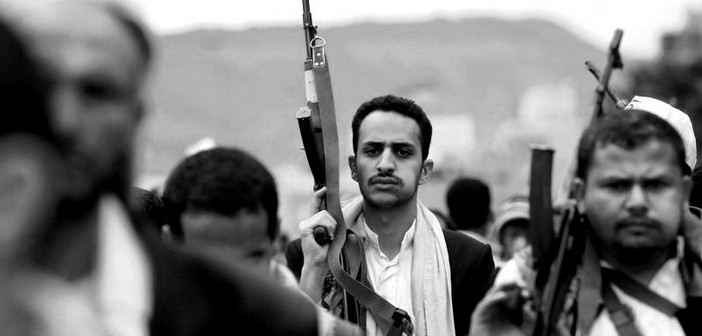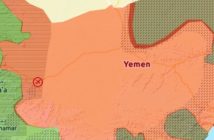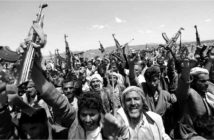It was clear since the beginning that the Yemeni popular uprising is quite different from the “Arab Spring revolutions” that commenced in Tunisia, even though it shares the same objectives: ousting despotic regimes and establishing new ones based on equal citizenship, freedom and, mainly, an economic and social program that can serve the interests of the poverty-stricken and marginalized groups of the population.
The revolution in Yemen has to deal with the problem of the national identity, which was clearly evidenced in Sa’ada’s wars since 2004and when the Southern Movement began in 2007. The two issues illustrated that the central government in Sana’a had failed to achieve the national integration, resulting in the emergence of pre-national identities.
Indeed, the southern problem is the most complicated due to the nascent reunion of the country, which happened roughly 25 years ago. The new Yemeni single state created by merging two different political systems in 1990 experienced serious crises ending up in a brief civil war just four years later. The Saleh-led coalition included Islamists and traditional forces of Sheikhs and tribesmen managed to gain victory over the southerners. The Yemeni reunion in 1990 was realized after some 270 years of partition.
Meanwhile, the crisis and war in the Sa’ada governorate demonstrated that the 26 September republican regime has been unable to achieve national integration in the north of the country. Likewise, the Sana’a- based republican government has failed to bring about the needed modernization and development. It is quite safe to say that the republican system established by the 1962 revolution was as similar as the Imamate ruling. The Hashemite spiritual leaders were merely replaced by social dignitaries and tribal leaders. The power maintained by the northern elite of tribal sheiks, military commanders, some businessmen and traditional influential figures of judges and Hashemites.
In 2011, Saleh’s regime tried to turn the popular revolution into a political crisis with the opposition. The fact is that what happened in 2011 was a nation-wide popular uprising, however, its leadership was reformist rather than revolutionist in terms of its structure and ideology. As neither the uprising leaders nor the government were able to put an end of the long-standing dispute, regional and international intervention was imperative. A compromise was brokered by the Gulf Cooperation Council (GCC), known as the GCC’s Initiative. It mainly aimed to prevent a genuine change, simply to force Saleh to step down and reduce his influence, which did not happen. There was some artificial change in the high rank positions, while military, security and administrative systems remained unchanged. The government established under the GCC-brokered deal could not make real achievements and produce solutions to the major problems. The situations worsened further.
The Yemeni citizen felt that the opposition, which shared power with the regime appeared to be more corrupt and narrow-minded. Indeed, it did not have a different economic and social program. Consequently, large portions of the population were disappointed, some of them re-aligned themselves behind Saleh’s regime. With the increased social crisis, national predicament became deeper and pre-national discourses surged Saleh’s camp and the Houthi group could mobilize large number of the northern Zaidi-tribal population on tribal and sectarian basis. They capitalized on the failure of the traditional opposition, which was presented as the representative of the popular uprising. They also exploited the concerns of the people in the northern regions about their interests in the future under the proposed six provinces federal state. Given that the majority of the people in the northern areas largely depend on their jobs in the military and security sectors to secure their incomes, the Saleh-Houthi alliance campaigned against the proposal of the new federal state. They adopted a sectarian and provincial rhetoric, arguing that the opposition and southerners’ demands for changing the form of the state and embracing federation aimed to deprive the northerners from their main living income source: employment in the military and security sectors.
Against this background, the nation-wide popular uprising turned into a political crisis and the Saleh-Houthi alliance turned it into a civil conflict that in turn became a regional proxy war between Saudi Arabia’s allies and Iran’s.
Accordingly, Saudi Arabia rushed to directly intervene militarily through the “Decisive Storm” operation, as it has lost most of its allies, such as the Muslim Brotherhoods and tribal influential figures against whom it has acted to undermine their influence in Yemen as well as to curb the influence of Arab Uprisings. Yemen has turned into a battlefield of direct or regional proxy war. The fact is that these regional powers moved basically to thwart Arab revolutions fearing that such uprising may reach their own countries. They intended also to fill the vacuum created by the American withdrawal from the region and to boost their own influence.
Obviously, the key regional players along with their international backers seem to be in control of the actions in Yemen. Regardless of the stance toward the Saudi intervention, certainly it has largely weakened the forces of Ali Saleh and the Houthis. For instance, the Yemeni air force has been severely damaged. Therefore the Saleh-Houthi alliance’s military strength is largely undermined, making it very difficult to gain swift and overall victory on the ground. It seems now that battles have come to static and stagnant state as no party is capable of realizing significant progress. The popular resistance forces are still ill organized, scattered and lacking an integrated political program. This is perhaps the reason why Saudi Arabia and its allies have been reluctant about financing and arming the resistance forces at large scale. There are several reasons beyond their reluctance. One reason is that they have not come to a final decision about aiding the Al-Islah Party (a Sunni religious political party) which apparently seems to be qualified to undertake this task. They also have not yet made their decision concerning support to influential figures like general Ali Mohssein Al-Ahmer, the reason may be related to their vision about the region’s future. There are other reasons including the fear that weapons may go for terrorist groups such as Al-Qaeda and similar Islamist militants. There are perhaps pressures by the United Sates, which have priorities quite different of Saudi Arabia, particularly concerning the negotiations with Iran over its nuclear program.
Undoubtedly, increasing the Saudi air strikes operation will boost the Saleh-Houthi alliance. It is also set to drive many people—who view Saudi leadership as Yemen’s number one enemy—to join this grouping. Thus social polarization and division on the basis of regional and sectarian motives will be further deepened. This aerial bombardment, however, does weaken the Saleh-Houthi alliance more and more, especially as it makes it so difficult for them to make up for the military equipment under the blockade. The local popular resistance groups are increasingly improved in terms of organization and training as we have seen in the governorates of Taiz, Marib and Al-Dale’a. That is to say, time is not in favor of the Saleh-Houthi alliance. Especially, given that Saudi Arabia doesn’t face any serious pressure by the international community. More to the point, ground military intervention is more likely now with the Houthis attacks against Negran and Jazan, which might have some propaganda’s effects but did not make any difference on the ground.
Yemen is now going through civil war and it is a battlefield of regional war with overlapping borders (despite it partially reflecting one of the Arab uprisings’ outcomes, which has proved the fragility of national borders, besides that it is somehow being an Arab-civil war and Islamic civil war). Like any civil war, we are talking about months and years of conflict during which equations and calculations may be changed frequently.
Though it seems ostensibly that the regional war parties are the only key players today, and the attempt to show that the only option is either to join the Saudi camp and ten coalition members or to align behind the Saleh-Houthi reactionary alliance, yet that doesn’t carry any real solution to any of the people’s problems, it rather worsens their situation. It does counterfeit the true nature of the conflict between revolutionary movement and its local and international enemies.
These revolutionary forces today need to constitute an independent political center, getting rid of illusions about the organization and about carrying weapons in the country of the civil and regional war.




